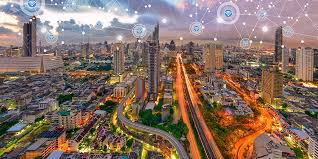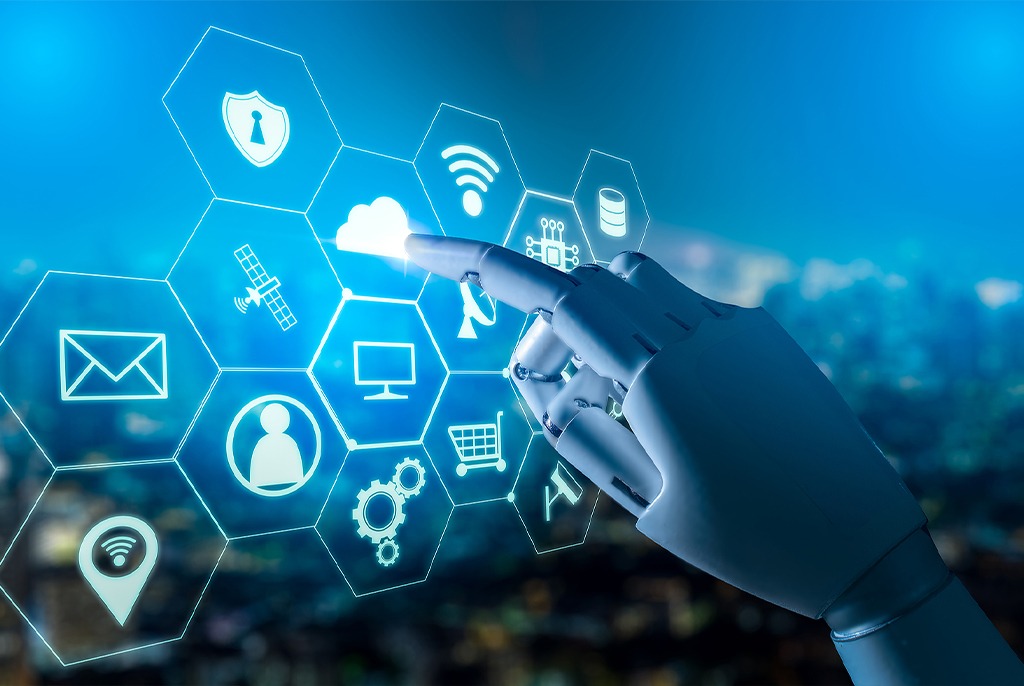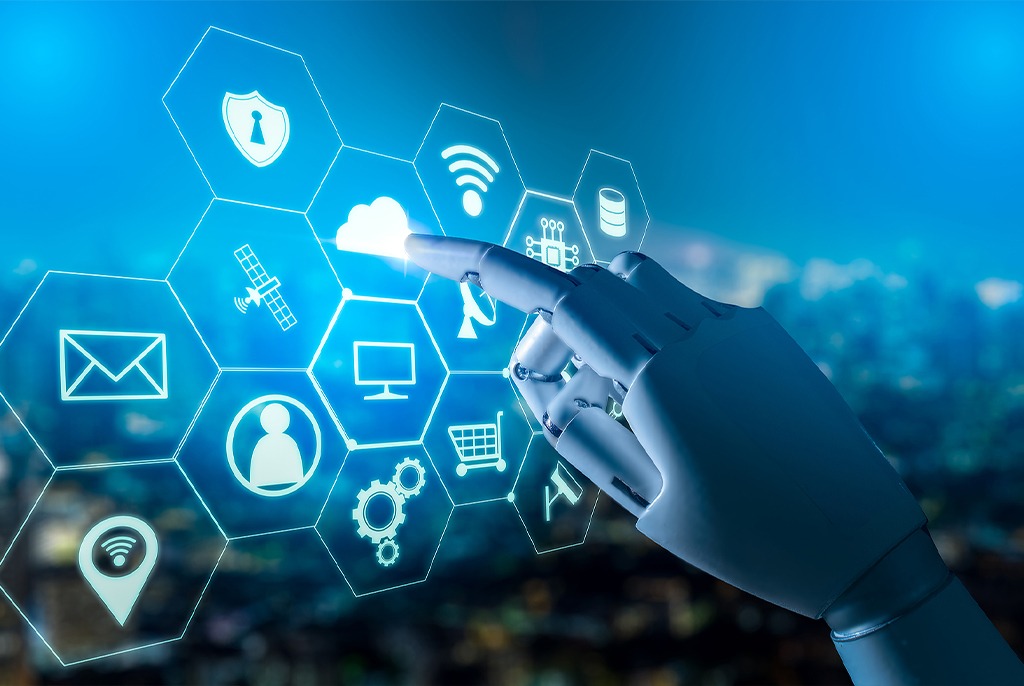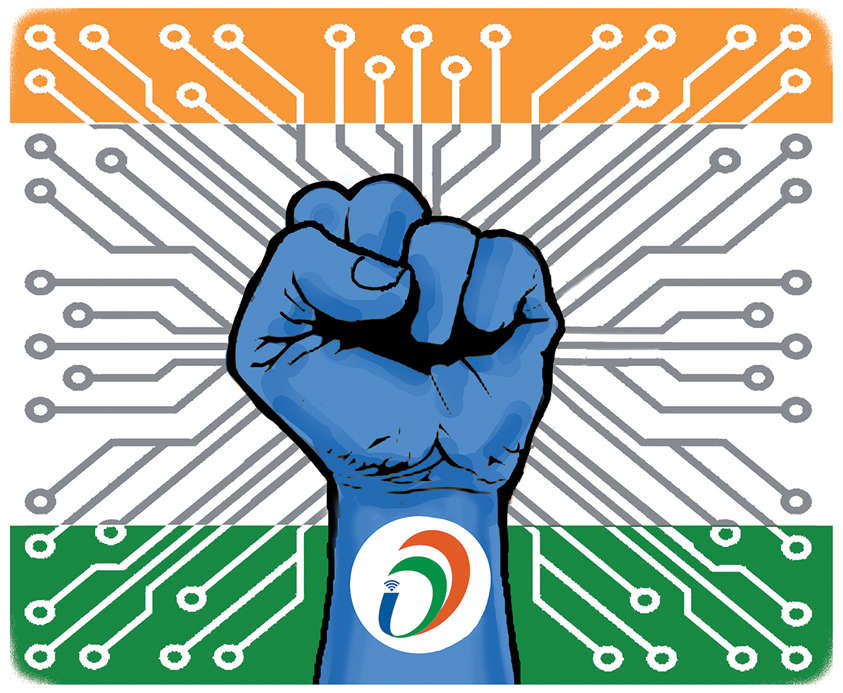
Smart Cities: What the Future of Urban Living Looks Like
Smart cities use advanced technologies like IoT, AI, and smart grids to improve urban life. They optimize transport, energy, healthcare, and waste systems, making cities more efficient, sustainable, and citizen-focused. While they offer better mobility, environmental benefits, and quality of life, challenges like cybersecurity, high costs, and infrastructure upgrades must be addressed.
✨ Raghav Jain

Introduction
Urbanization is accelerating at an unprecedented pace, and cities around the world are grappling with challenges like traffic congestion, pollution, energy shortages, and population growth. The solution lies in the concept of smart cities—urban areas that leverage technology, data, and innovation to create more efficient, sustainable, and livable environments.
Smart cities aim to improve the quality of life for residents while reducing the environmental footprint of urban living. They integrate digital infrastructure, IoT devices, renewable energy, intelligent transport systems, and citizen-centric services to transform traditional cities into hubs of innovation and convenience.
In this article, we’ll explore what smart cities are, the technology behind them, benefits for citizens, challenges, and how urban living might evolve in the near future. The concept of smart cities represents a transformative approach to urban living, blending technology, sustainability, and human-centric design to improve the quality of life for residents. As the world experiences rapid urbanization, cities are facing unprecedented challenges, from traffic congestion and pollution to inefficient energy use and strained public services. Traditional urban planning methods often fall short in addressing these complexities, making the integration of intelligent systems not just desirable but essential. Smart cities leverage digital technology, data analytics, and the Internet of Things (IoT) to create interconnected environments where resources are optimized, services are streamlined, and citizens are actively engaged in shaping their communities.
At the core of smart cities is the collection and utilization of real-time data. Sensors, cameras, and connected devices monitor everything from traffic flow and air quality to energy consumption and water usage. This data-driven approach allows city planners and administrators to make informed decisions quickly, anticipate problems before they escalate, and allocate resources efficiently. For example, intelligent traffic management systems can adjust signal timings dynamically, reducing congestion and travel time. Similarly, smart grids monitor electricity demand and supply in real-time, minimizing wastage and supporting the integration of renewable energy sources. This level of responsiveness creates a city that not only reacts to immediate needs but also plans proactively for the future.
One of the most significant benefits of smart cities is sustainability. With climate change posing an existential threat, urban centers must adopt environmentally conscious practices. Smart infrastructure enables efficient energy consumption, waste management, and water distribution, reducing the ecological footprint of cities. Buildings equipped with sensors can regulate heating, cooling, and lighting automatically, optimizing energy use based on occupancy and weather conditions. Waste management systems can track collection patterns and predict the most efficient routes for garbage trucks, decreasing fuel consumption and emissions. Water distribution networks monitor leaks and usage patterns, conserving precious resources. Collectively, these initiatives contribute to greener, more resilient urban environments that prioritize long-term ecological balance.
Connectivity and mobility also define the smart city experience. Urban residents increasingly demand seamless transportation options that are convenient, affordable, and sustainable. Smart cities employ a combination of autonomous vehicles, electric public transportation, ride-sharing platforms, and bike-sharing systems, all coordinated through real-time data analytics. Mobile applications provide residents with instant updates on traffic conditions, public transit schedules, and available parking spaces, enabling more efficient travel choices. By reducing reliance on private vehicles, cities can alleviate congestion, cut emissions, and improve air quality, creating a healthier urban environment. Furthermore, enhanced mobility ensures equitable access to essential services, such as healthcare and education, especially for marginalized communities.
Public safety and healthcare are also enhanced through smart city technologies. Surveillance systems integrated with artificial intelligence can detect unusual behavior or emergencies, enabling rapid response from law enforcement or emergency services. Similarly, healthcare facilities benefit from connected devices that monitor patient health, predict disease outbreaks, and manage medical resources more effectively. In a smart city, residents have access to safer, more responsive services that anticipate their needs rather than merely reacting to crises. This proactive approach fosters trust and a sense of security, which is crucial for thriving urban communities.
Citizen engagement is another hallmark of smart cities. Technology allows residents to actively participate in decision-making processes, providing feedback on public services, reporting issues, and contributing ideas for urban development. Digital platforms and mobile apps bridge the gap between government and citizens, ensuring that policies reflect the priorities and concerns of the community. This participatory model not only improves transparency and accountability but also strengthens social cohesion by making people feel invested in the well-being of their city.
Despite the promise of smart cities, challenges remain. The reliance on technology raises concerns about privacy, cybersecurity, and data ownership. Ensuring equitable access to smart services is also critical, as disparities in digital literacy and infrastructure can exacerbate social inequality. Moreover, the initial investment in smart infrastructure can be substantial, requiring careful planning and sustainable financing models. Policymakers, urban planners, and technology providers must collaborate to create solutions that are inclusive, secure, and adaptable to changing needs.
The future of urban living lies in cities that are intelligent, sustainable, and human-centric. By integrating cutting-edge technologies with data-driven planning, smart cities offer residents enhanced convenience, safety, and quality of life. They balance the demands of growth with environmental stewardship, ensuring that urban development does not come at the expense of natural resources or social equity. In this vision of the future, urban environments are not just places where people live and work—they are dynamic ecosystems where technology, community, and sustainability converge to create resilient and vibrant cities.
In conclusion, smart cities are more than just a technological trend—they represent a fundamental shift in how we design, manage, and inhabit urban spaces. By harnessing data, connectivity, and citizen participation, they offer solutions to some of the most pressing challenges of urbanization, from congestion and pollution to energy inefficiency and social inequality. While obstacles exist, the potential benefits are immense: smarter, safer, greener, and more inclusive cities that improve the quality of life for everyone. As we look ahead, the development of smart cities will be a defining factor in shaping a sustainable and prosperous future, demonstrating that technology, when applied thoughtfully, can transform urban living into a more intelligent, responsive, and harmonious experience.
Understanding Smart Cities
A smart city uses information and communication technologies (ICT) to enhance infrastructure, optimize resources, and improve the delivery of services. The core idea is to create a city that is:
- Sustainable: Reduced emissions, efficient energy use, and greener spaces
- Connected: Seamless communication between devices, transport, and utilities
- Citizen-focused: Services tailored to residents’ needs and lifestyles
- Data-driven: Decisions powered by real-time information for better planning
Key components of smart cities include smart transportation, energy management, waste management, water management, security, healthcare, education, and governance.
Key Features of Smart Cities
1. Intelligent Transportation Systems
Smart cities use sensors, GPS tracking, and AI algorithms to monitor traffic, reduce congestion, and optimize public transport. Benefits include:
- Reduced travel time
- Lower fuel consumption
- Safer roads with predictive accident alerts
- Integration with apps for real-time transit updates
2. Smart Energy Management
Energy grids are made more efficient with smart meters, renewable energy integration, and AI-based energy distribution. Advantages:
- Lower energy wastage
- Reduced carbon footprint
- Real-time monitoring for outages and efficiency
3. Sustainable Infrastructure
Buildings and homes in smart cities are equipped with energy-efficient appliances, solar panels, and automated climate control systems. Features include:
- Green rooftops and urban gardens
- Automated water and energy usage tracking
- Eco-friendly construction materials
4. Waste and Water Management
Smart sensors monitor garbage bins, water pipelines, and sewage systems to prevent overflow, wastage, and contamination. Benefits:
- Cleaner streets and public spaces
- Efficient recycling and composting
- Reduced water losses and leak detection
5. Connected Healthcare
Telemedicine, wearable devices, and AI diagnostics provide accessible healthcare. Residents benefit from:
- Remote consultations and early disease detection
- Health monitoring through wearable devices
- Efficient emergency response services
6. Safety and Security
CCTV cameras, AI-based surveillance, and smart street lighting help cities remain secure. Outcomes:
- Crime prevention with predictive policing
- Faster emergency response
- Safer public spaces
7. Smart Governance
E-governance platforms allow residents to access government services online, lodge complaints, and participate in decision-making. Results:
- Reduced bureaucracy
- Transparency in administration
- Faster and more effective civic problem resolution
Technologies Driving Smart Cities
- Internet of Things (IoT): Connects devices for data collection and monitoring
- Artificial Intelligence (AI): Predictive analytics for traffic, energy, and public safety
- Big Data Analytics: Informs urban planning and resource allocation
- 5G Networks: Enables faster, real-time communication across systems
- Blockchain: Secures data and improves transparency
- Renewable Energy Tech: Solar panels, wind energy, and energy storage systems
Benefits of Smart Cities for Citizens
- Improved Quality of Life
- Smart cities provide cleaner air, efficient transport, better healthcare, and safer environments.
- Sustainability and Environmental Protection
- By reducing emissions, optimizing energy, and managing waste effectively, cities can combat climate change.
- Enhanced Economic Opportunities
- Smart cities attract startups, tech companies, and innovation hubs, creating new jobs and businesses.
- Time and Resource Efficiency
- AI and IoT reduce commuting time, energy consumption, and bureaucratic delays.
- Inclusive and Citizen-Centric Services
- Mobile apps and digital platforms ensure that citizens’ voices are heard, and services are personalized.
Daily Life in a Smart City
- Morning:
- Smart home devices automatically adjust temperature, start appliances, and provide real-time traffic updates for your commute.
- Commuting:
- Connected public transport apps guide you to the fastest routes, electric buses reduce pollution, and bike-sharing systems encourage sustainable travel.
- Work & Services:
- E-governance portals allow utility payments, healthcare bookings, and civic complaints online, saving time and effort.
- Leisure & Environment:
- Urban parks with sensor-driven irrigation, pollution monitoring apps, and clean streets make outdoor time healthier and enjoyable.
- Evening:
- Street lighting adapts to pedestrian presence, energy consumption is automatically optimized at home, and smart healthcare wearables monitor your health metrics.
Challenges of Building Smart Cities
- High Initial Investment
- Setting up smart infrastructure requires significant funding.
- Data Privacy Concerns
- Massive data collection can raise surveillance and privacy issues.
- Integration Complexity
- Connecting existing infrastructure with new technology can be challenging.
- Digital Divide
- Not all residents may have access to smartphones or internet connectivity.
- Cybersecurity Risks
- Smart systems are vulnerable to hacking and cyber threats.
Future Trends in Smart Cities
- Autonomous Vehicles: Self-driving buses and cars for safer and efficient transport
- AI-Powered Urban Planning: Cities adapting in real-time to population needs
- Sustainable Living Spaces: Net-zero energy buildings and vertical gardens
- Blockchain-Based Governance: Transparent, secure digital records and transactions
- Green Mobility Solutions: Electric scooters, e-bikes, and smart charging stations
- Citizen Engagement Platforms: Mobile apps for real-time feedback, voting, and services
Daily Practices for Residents of a Smart City
- Stay Informed: Use city apps for updates on traffic, air quality, and services
- Use Sustainable Transport: Prefer bicycles, e-vehicles, or public transport
- Conserve Energy: Leverage smart meters, solar power, and energy-efficient appliances
- Participate in Civic Programs: Report issues, attend workshops, and provide feedback
- Adopt Green Habits: Reduce waste, recycle, and plant trees whenever possible
Common Myths About Smart Cities: Busted!
“Smart cities are only about technology.”
→ False! They also focus on sustainability, governance, and citizen well-being.
“Only big cities can become smart.”
→ Wrong! Small towns can implement scalable smart solutions too.
“Smart cities eliminate human jobs.”
→ Not entirely. Technology creates new jobs in AI, data management, and maintenance.
“Privacy is impossible in smart cities.”
→ With strong cybersecurity and regulations, personal data can be protected.
“Smart cities are unaffordable.”
→ Modular, step-by-step implementation makes it feasible for most urban areas.
Conclusion
Smart cities represent the future of urban living, combining technology, sustainability, and citizen-centric solutions to address modern challenges. They promise cleaner air, efficient transport, intelligent energy use, safer streets, and an overall higher quality of life.
The journey toward smart cities is gradual but transformative. Every small step—adopting energy-efficient appliances, using public transport, or participating in local digital initiatives—contributes to a smarter, greener, and more livable urban environment.
The future is not just about buildings and gadgets, it’s about creating cities that are resilient, inclusive, and human-centric. By embracing innovation and sustainability, urban living can become healthier, faster, and more enjoyable for everyone.
Engage with your city, use technology wisely, adopt green habits, and contribute to building the smart cities of tomorrow. Your city—and your future—will thank you.
Q&A Section
Q1:- What is a smart city and how does it differ from a traditional city?
Ans :- A smart city integrates technology, data, and IoT to optimize urban services like traffic, energy, healthcare, and waste management, improving efficiency, sustainability, and quality of life compared to traditional cities.
Q2:- How does IoT contribute to the development of smart cities?
Ans :- IoT sensors collect real-time data from infrastructure, vehicles, and public utilities, enabling smarter traffic management, energy conservation, pollution control, and responsive public services.
Q3:- What role does AI play in urban planning and governance?
Ans :- AI analyzes data patterns to optimize city planning, predict emergencies, manage resources, and improve citizen services, making urban governance proactive rather than reactive.
Q4:- How do smart transportation systems improve urban mobility?
Ans :- Smart transportation uses AI, sensors, and connected devices to reduce congestion, improve public transit efficiency, enable autonomous vehicles, and lower carbon emissions.
Q5:- How does sustainable energy use fit into smart city infrastructure?
Ans :- Smart cities rely on renewable energy, smart grids, and energy-efficient buildings to reduce environmental impact, optimize electricity use, and support green urban living.
Q6:- What are the benefits of smart healthcare in urban areas?
Ans :- Connected devices, telemedicine, and AI-driven health monitoring provide faster diagnosis, real-time patient care, and better resource allocation, improving overall urban healthcare.
Q7:- How does data privacy and cybersecurity affect smart city development?
Ans :- Protecting citizens’ data and ensuring secure networks is crucial, as massive data collection in smart cities can be vulnerable to cyberattacks and misuse without proper safeguards.
Q8:- What is the impact of smart waste and water management systems?
Ans :- Smart sensors and AI optimize waste collection routes, monitor water quality, detect leaks, and promote recycling, enhancing efficiency and sustainability in urban services.
Q9:- How do smart cities enhance citizen engagement and quality of life?
Ans :- Digital platforms and mobile apps allow citizens to access services, provide feedback, report issues, and participate in decision-making, creating more responsive and inclusive urban environments.
Q10:- What challenges do cities face while transitioning to smart urban living?
Ans :- High costs, infrastructure upgrades, digital literacy gaps, regulatory hurdles, and ensuring data security are major challenges cities must address to implement smart city technologies successfully.
Similar Articles
Find more relatable content in similar Articles

MakeAnAppLike – Shares trendin..
“MakeAnAppLike is a comprehens.. Read More

Technazo* – Fresh tech trends,..
Technazo is a dynamic platform.. Read More

Digital India: How Technology ..
Digital India leverages techn.. Read More

Daily.dev* – Developer-focused..
Daily.dev is a developer-focus.. Read More
Explore Other Categories
Explore many different categories of articles ranging from Gadgets to Security
Smart Devices, Gear & Innovations
Discover in-depth reviews, hands-on experiences, and expert insights on the newest gadgets—from smartphones to smartwatches, headphones, wearables, and everything in between. Stay ahead with the latest in tech gear
Apps That Power Your World
Explore essential mobile and desktop applications across all platforms. From productivity boosters to creative tools, we cover updates, recommendations, and how-tos to make your digital life easier and more efficient.
Tomorrow's Technology, Today's Insights
Dive into the world of emerging technologies, AI breakthroughs, space tech, robotics, and innovations shaping the future. Stay informed on what's next in the evolution of science and technology.
Protecting You in a Digital Age
Learn how to secure your data, protect your privacy, and understand the latest in online threats. We break down complex cybersecurity topics into practical advice for everyday users and professionals alike.
© 2025 Copyrights by rTechnology. All Rights Reserved.